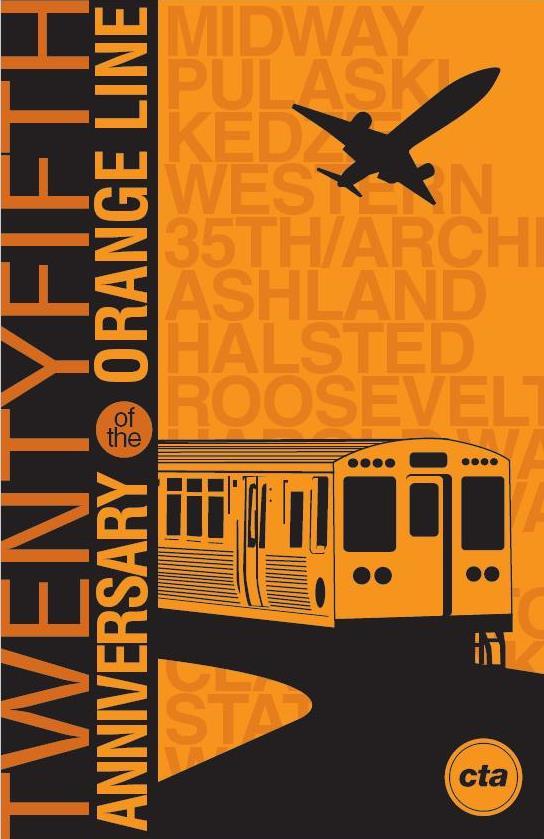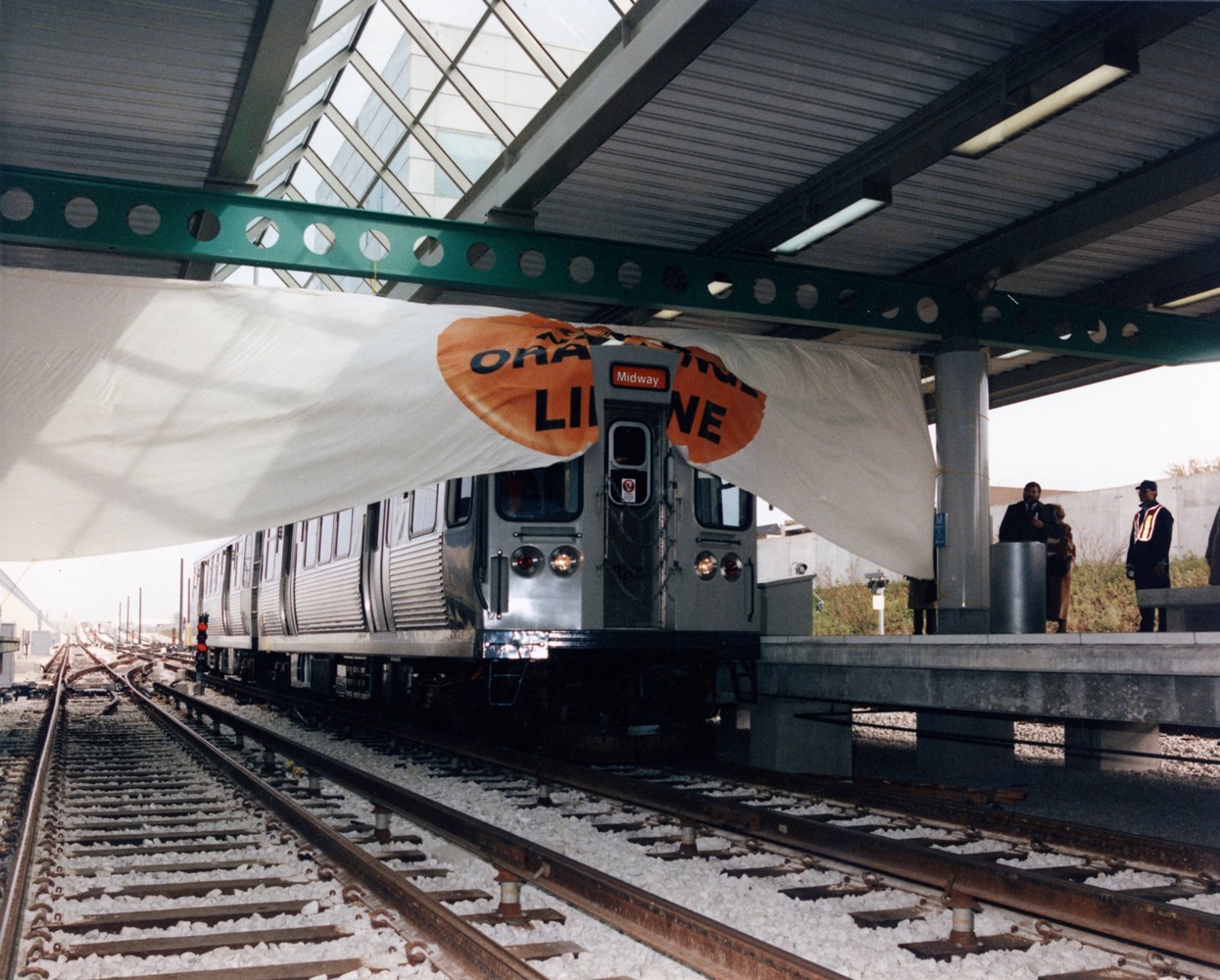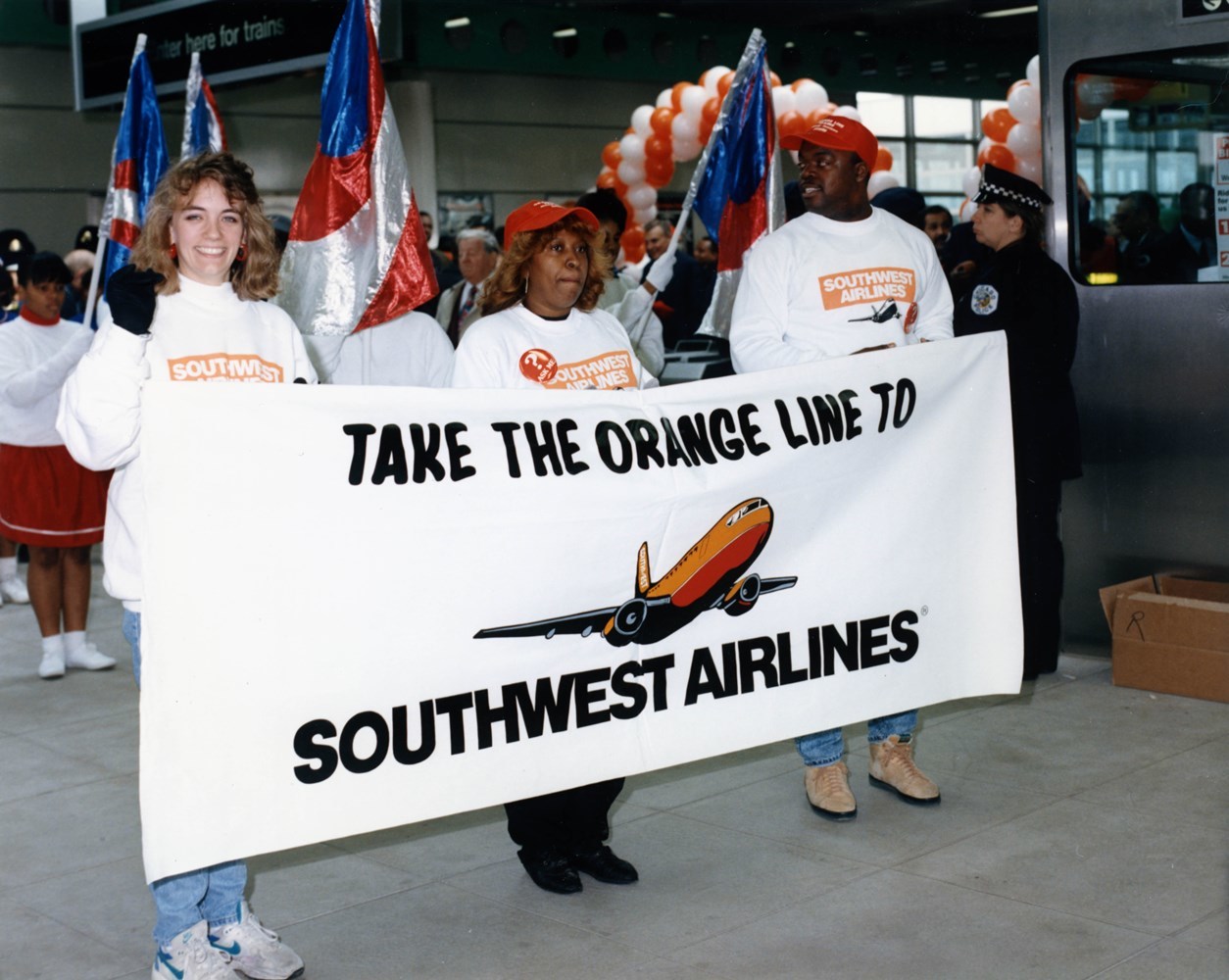Update on Midway Modernization Project, commemorative posters and fun giveaway among the highlights of celebration
The Chicago Transit Authority today commemorated the 25th anniversary of its Orange Line service with a celebration at Midway Station, featuring commemorative posters and free oranges to travelers and remarks by CTA President Dorval Carter, U.S. Congressman Dan Lipinski, retired U.S. Congressman Bill Lipinski, Chicago Aviation Department Commissioner Jamie Rhee and Southwest Airlines’ Community Affairs Manager Patty Greene. The event also included an update for customers on the Midway Modernization Project.
“For the past quarter-century, the Orange Line has flown customers past street and highway traffic on their travels between downtown, the southwest side of Chicago and flights out of Midway Airport,” said CTA President Carter. “This service helped create economic growth and development for our city, while also establishing Midway as a major Midwest hub for Southwest Airlines and air travelers across the country.”

The Orange Line boasts several distinctions in Chicago history. When service began on October 31, 1993, it was the most recent rail line built from scratch and the first ‘L’ line to open with a color name. The 13-mile, 16-station service helped establish Chicago as the only city in the United State to have more than one airport connected to rapid transit. The Orange Line also was the first rail line with just a single crewman operating a train, now standard procedure on the entire ‘L’ system.
Southwest Chicago warmly welcomed the Orange Line when it opened, since the area had gone decades without any rapid transit. The Douglas Branch of the Metropolitan ‘L’ (a predecessor of the CTA) served what was then the southwest side in 1895. But the city rapidly expanded far south of 22nd Street and west of the South Side ‘L’ tracks, leaving a significant quadrant of the city unserved. For the next 90 years, various plans were proposed, but ultimately, failed to garner enough federal funding to make rapid transit a reality.
Finally, in 1986, President Ronald Reagan struck a funding deal with Chicago Mayor Harold Washington, part of a political favor to Representative William Lipinski (D-Ill.) for a vote cast on an issue important to the president. The rapid transit line is credited with establishing Midway Airport as a major facility for visitors flying to Chicago or residents traveling to other U.S. destinations.
Brief Historic Description of the Orange Line:
As far back as the 1940s, when the State Street and Dearborn Street subways were being planned and constructed, the city proposed an elaborate system of subways to expand the "L" system, including a southwest route from the Loop to Municipal (now Midway) Airport.
For nearly fifty years, various plans continued to be put forth. When the Stevenson Expressway was constructed, space was left in much of its length for a median rapid transit route (as was done in the Congress, Dan Ryan, and Kennedy Expressways), though this was never utilized. This may have been for the best: putting an ‘L’ line in the median of an expressway often isolates it from the neighborhood it's supposed to serve.
Unfortunately, the citizens of this area would have to wait for several decades before rapid transit would reach them. In 1980, Mayor Byrne announced the plans for the new Southwest Route using money from the canceled Crosstown Expressway, but a lack of federal funding assistance stalled the plan.
The 1986 funding deal struck between President Ronald Reagan and Mayor Washington finally made the rail line a reality. The $400 million line is unusual in that it predominantly follows current or former freight railroad right-of-ways, including those previously used by the Illinois Central Railroad, Santa Fe Railway and the Belt Railway of Chicago. The Midway (Orange) Line begins and ends at a terminal at Midway Airport (actually at 59th/Kilpatrick, across the street from the airport; this was done to allow easier extension of the line), then follows the Belt Railway of Chicago, 49th Street, Leavitt Avenue, Archer Avenue, and the Stevenson Expressway to a connection with the former Dan Ryan elevated tracks at 18th and Federal. At this point, the Orange Line follows the South Side elevated to the Loop, where it terminates, clockwise, on the inner track.
The route has seven stations approximately one mile apart (an eighth was planned, but never built at California/49th) on the nine mile line, plus a new station at Roosevelt/Wabash to serve Orange and Green Line trains. The Midway terminal also includes a spacious yard and modern inspection shop, plus a layout conducive to extension south to Ford City (something planned in the early stages of the Southwest Route, but as yet unrealized).
On October 31, 1993, the Orange Line began operation at 0730 hours between Midway and the Loop. The line was unusual in several ways, a harbinger of things to come on the CTA rapid transit system. The line opened entirely equipped with brand-new 3200-series cars, which had full-width cabs, allowing one-person train operation (OPTO). Only the Yellow Line had OPTO, which had been a feature since its opening in 1964; in two years, it would begin spreading to the rest of the system.
Other distinctions of the Orange Line:
- The Orange Line is the most recent line to be built from scratch, opening on October 31, 1993.
- The Orange Line was the first ‘L’ line to open with a color name (although it was called the "Southwest Route" when it was being planned, reflecting the directional names that many routes had from the 1950s to the 1990s).
- Every station on the line was ADA-compliant
- All but Ashland, Kedzie and Roosevelt had park'n'ride lots (Kedzie had one added in 1999)
- All had bus bays and turnarounds to facilitate intermodal transfers.
- The line also began operation without owl (late night) service, running only Monday through Saturday from 0500 to 2300 hours and Sundays/Holidays from 0730 to 2330 hours. But ridership proved better than expected and more trips were soon added. Today, the Orange Line serves as an integral part of the CTA's rapid transit system.
- The new 3200-series cars were ordered in conjunction with this project.
- The Orange Line was the first to use single-crewman operations, now standard on the whole ‘L’ system.
The Midway station serves its namesake airport and major air carrier, Southwest Airlines, and originally was connected by a long elevated, enclosed skywalk with moving walkways in both directions. Although this was a somewhat long walk, it was safe and protected from the elements, and the moving belts made the trip a bit less onerous. Chicago is the only city in the United States to have more than one airport connected to rapid transit. The station is situated outside of the airport structure and the platform is depressed below grade purposely to facilitate the planned extension of this line south to the Ford City Shopping Center at 76th and Cicero. (Interestingly, the roller curtain that the trains' destination signs use originally included one for Ford City.)
Service Notes on the Orange Line:
Hours of Operation:
3:30am-1:05am weekdays;
4am-1:05am Saturdays;
4:03am-1:05am Sundays
Length of Route: 13 miles
Midway branch: 9.2 miles
South Side Elevated: 1.8 miles
Loop Elevated: 2.0 miles
Number of Stations: 16 stations
Car Types Assigned: 2600-series, 3200-series


# # #